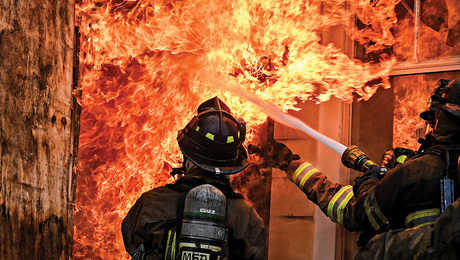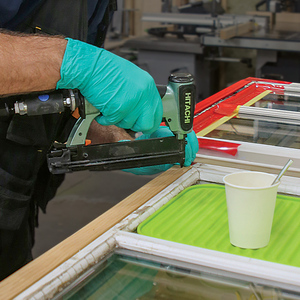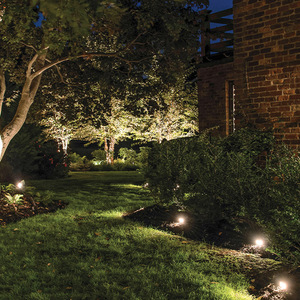Woodstove to augment hydronic heat
I live in a cape style log home with oil fired hydronic/baseboard heat and a woodstove for backup. The woodstove sits in front of the central chimney in the living room, directly over the boiler which is in the basement. We run the stove on a regular basis during the coldest Vermont winter months. Being near the stairs, much of the heat from the stove rises up the stairwell and (over)heats the upstairs which we don’t use much. In the past, I’ve tried using small fans to circulate the hot air around the downstairs, but with limited success. With the rising cost of oil, I’ve been trying to think of ways to better utilize the heat from the stove.
It occurred to me that I already have a system in place for distributing heat around the house……I just need to link the stove to it. Here’s what I’m thinking about: The radiators are in a single loop….well, actually one zone for each floor. It would be easy to tap into the downstairs loop just before it returns to the boiler and build a heat exchanger behind the stove to re-heat (or preheat) the water.
I can’t see any down-side, only some design issues.
1. Would I need to incorporate a pressure relief valve, or would the one just under in the basement serve?
2. Best design for the exchanger: I’ve seen a domestic hot water setup where someone drilled holes in the stove and ran black pipe directly through the firebox. I don’t like this, I’d prefer this to be free standing if possible. I’m thinking about using 3/4″ copper and using L fittings to make a zig-zag which would stand in the small gap behind the stove, in the small space between the stove and the brick chimney.
I’m a little concerned about what happens if the stove is running when the boiler is off. Pressure issues and if the water drains out of the exchanger, the sweat joints might get hot enough to melt. Maybe use flexible copper or black pipe?
Anyway, I’d appreciate anybody telling me if this is hare-brained or bouncing any better ideas my way.



















Replies
This is more of a "no answer bump" than a good answer, but...could you build in some sort of relay or something that would not allow the boiler pump to be turned off while the stove was running?--maybe a temperature sensor or something?
There's probably a way, but that would be something else I'd have to rely on the expertise of you folks to figure out. I still wonder if the existing relief valve, and expansion tank would handle it. Maybe I could use the type of relief valve that goes on a water heater. Then I could route the overflow somewhere other than the living room floor.
Edit: After giving the idea of a relay more thought, I don't think it would work in my case. We live in a rural area and can count on losing power several times each winter. We then rely on the woodstove as the only source of heat and there would be no power to trip a relay or run a circulator. No power also means no water to replace anything that blows out a relief valve...well there is usually a bit in the pressure tank, but we try to conserve that until the power is back on.
Edited 7/5/2008 5:08 am ET by Tommymc
There's an excellent web site dedicated to wood stoves with an message board. Someone posted a link to it here sometime last winter.
http://www.woodheat.org/index.htm
Anyhow, it's sure to be a better resource than BT. There are some knowledgeable people here but that site's got everything.
Thanks...I'll check it out.
I'm not familiar enough with either system to know, but would the way 'outdoor wood furnaces' operate be adaptable to what you are trying to do?
Paul
I'm not that familiar with outdoor furnaces, but I understand them to be a primary source of central heat....a replacement boiler rather than a tie-in. I really think everybody is seeing this too much as a wood heat issue. I actually started out thinking of using solar collectors to do the same thing, the way some DHW tanks are set up. Then I realized that because of freezing temps, solar is much more expensive and complicated...anti-freeze etc.
I have a pot of water that sits on the woodstove as a humidifier, and it rarely gets hot enough to boil, at best a simmer. So I'm thinking that a water filled coil sitting an inch or two away from the back of the stove will get hot but not boil. Being in a closed system, the water may react differently than in an open pot, and I guess that's one of my main concerns...is there enough tolerance built into the normal plumbing to absorb this. I suspect the answer is yes, but want to be sure. The systen has the normal pressure tank and relief valves. There would be no shutoffs between my heat exchanger and the nearest relief valve in the basement.
I won't have much money invested in this....I havent priced copper for a few years, but I'd expect to get out of this for $50-$100. Will it even heat the water enough to make it worth the effort? I'm not sure, but it seems a small enough risk of capital. I could build the exchanger (with a relief valve) fill it with water and test it before hooking it into the system. I just don't want to screw up my hydronic central heat. For instance, what how seriously would this affect flow rate through the radiators by adding the series of U's that will be the heat exchanger? Would this have less impact if I used soft copper and made a coil? The more I think it through, the more I see it as a plumbing and heating issue rather than specific to wood heat. I appreciate any suggestions.
are you trying to bring the wood fired on line to sub for the oil fired???
Life is not a journey to the grave with the intention of arriving safely in a pretty and well preserved body, but rather to skid in broadside, thoroughly used up, totally worn out, and loudly proclaiming
WOW!!! What a Ride!
Forget the primal scream, just ROAR!!!
No, just thinking I can give the oil fired system a boost by preheating the return flow before it circulates back through the boiler. It seems to me that the warmer the circulating water stays, the less the often the oil burner will fire up.
There will be occasions when the woodstove will be operating and the oil system is not. Power outages are a good example. During those periods, I'm not expecting anything out of the preheater, but since the water won't be circulating it may get hot and build up pressure. I'm wondering if the normal pressure checks built into the oil system will handle this.
Also, I'm wondering if all the extra bends involved in the preheater will interfere with normal circulation, or if there is enough tolerance built into the circulator pump. The house has a 24x36 footprint and the loop I'm going to tap into goes around the outter wall of the ground floor.
I believe that when the wood stove raises the ambient temperature it will influence the thermostat...
and the boiler's operation will be off and not allowing it to heat the floors as designed....
hence the overall thermal mass of the floors will be down and act as a heat sink...
I think the heat loss/recovery cycle would be best if left alone...
if you could add heat to the floors compliments of the wood stove thru conductance and not influence the thermostst(s) it would be a better bet....
once you externally influence the primary (or several) thermostat(s) you may be opening a can of worms...
Life is not a journey to the grave with the intention of arriving safely in a pretty and well preserved body, but rather to skid in broadside, thoroughly used up, totally worn out, and loudly proclaiming<!----><!----><!---->
WOW!!! What a Ride!Forget the primal scream, just ROAR!!!
"I believe that when the wood stove raises the ambient temperature it will influence the thermostat...and the boiler's operation will be off and not allowing it to heat the floors as designed...."
The woodstove is in the living room and a lot of the heat goes up the nearby stairwell. This does a great job heating the upper floor, but doesn't contribute much to the other rooms downstairs.... which is where we spend most of our time. Trying to move the air with fans just makes it feel drafty, so the result is that the downstairs thermostat still cycles on when the stove is burning, especially on the colder days. As long as the boiler is going to run I was hoping I could squeeze a little more efficiency out of it by pre-heating the water it's circulating.
So today we're having record high temps and I'm moaning like everybody else....wouldn't it be great if we could save some of this for winter? What we really need to do is figure a way to convert solar to something that can be stored, then burned. Solar-> electric-> hydrogen maybe?
PatchogPhil : I'll check the site out, thanks
Edited 7/7/2008 3:25 pm ET by Tommymc
Hmmm...A way to convert solar to something that can be stored, then burned. I've thought about this in the past and realized we already have the answer: firewood!
not to be blunt, but you're basically talking about building a potential bomb here.I have yet to see direct exchange from a wood stove done safely. doesn't mean it can't be done, I suppose, but I haven't seen it.Best case would be a gravity fed, failsafe (normally open, powered closed) dump zone like some wood boilers use. They generally also kill the fire too though by closing the damper. do you want to be unable to use the wood stove when the power is out?Fans are safer and cheaper. For what amounts to pretty much only a comfort benefit (this would not significantly increase output from the wood stove) I would deem it way too risky.-------------------------------------
-=Northeast Radiant Technology=-
Radiant Design, Consultation, Parts Supply
http://www.NRTradiant.com
"not to be blunt, but you're basically talking about building a potential bomb here."
Blunt is fine...that's why I'm asking for advice.....and I certainly am not into potential bombs!
"Fans are safer and cheaper. For what amounts to pretty much only a comfort benefit (this would not significantly increase output from the wood stove) I would deem it way too risky."
Re: fans, I've yet to figure a way to blow enough volume of air to matter without making it feel like a draft. I once toyed with the idea of a low noise bathroom fan mounted on the ceiling over the stove and running the exhaust duct into the further rooms. Can't figure a way to do it without either creating an eyesore of tearing out some walls. Maybe I need to give that some more thought.
BTW, I'm not trying to increase the output of the woodstove, just distribute the heat better. Since I already have one distribution system in place (hydronic baseboards) I was trying to think of how to use the woodstove to add heat to that system. It sounds like I need to go in another direction....thanks for the advice.
I see the conundrum. best bet is probably an open water jacket, with a water to water heat exchanger. that way your closed system is not at risk. but that might not be feasible either of course.-------------------------------------
-=Northeast Radiant Technology=-
Radiant Design, Consultation, Parts Supply
http://www.NRTradiant.com
Get yerself over to http://www.heatinghelp.com and click on "Questions" (a.k.a. THE WALL). Post your situation there. Bet you get all kinds of info from there...... if it has to do with heat, someone there will know about it.
Quantum materiae materietur marmota monax si marmota monax materiam possit materiari?